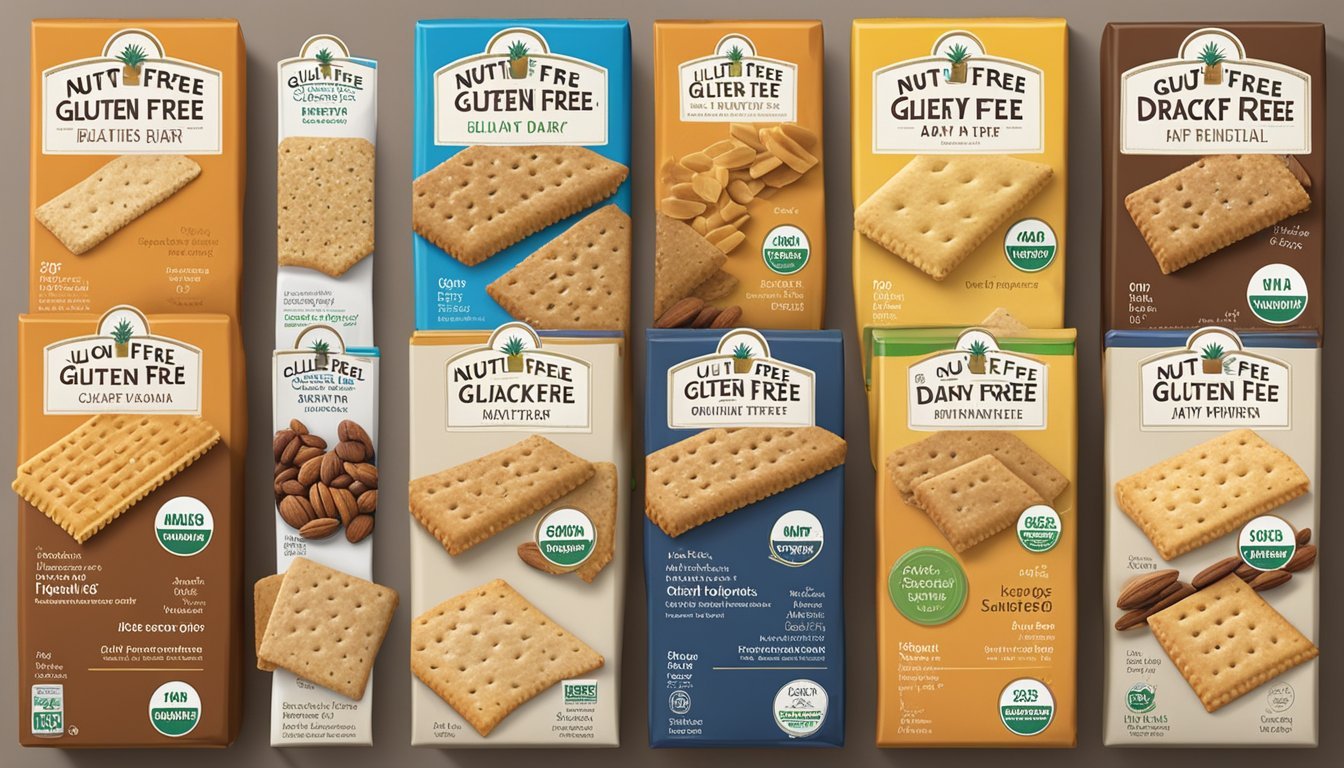Are Crackers Gluten-Free?
Understanding Your Snack Options
Navigating the world of snacking can be particularly challenging for individuals with gluten sensitivities or celiac disease. Crackers, a popular snack option, traditionally contain gluten, a protein found in wheat, barley, and rye. Gluten-free diets exclude these grains, so people who follow such a diet must find alternatives. The good news is that the rise of gluten consciousness has led to an increase in the variety of gluten-free cracker options available on the market.
Manufacturers have responded to the demand for gluten-free snacks by using alternative flours and grains such as rice, corn, beans, and seeds to create safe options. These gluten-free crackers come in various forms, including multiseed rice thins, bean crackers with added flavors such as lime or garlic, and even reimagined versions of traditionally wheat-based snacks like graham crackers using gluten-free ingredients.
Despite the expansion of gluten-free products, consumers need to be diligent. Not all crackers labeled as gluten-free are created equal, and cross-contamination during processing can be a concern. For peace of mind, it is essential to look for certifications or endorsements from reputable celiac disease organizations or to stick to brands that are recognized for their strict gluten-free manufacturing processes.
Understanding Gluten and Celiac Disease
In this section, readers will gain a fundamental understanding of gluten, its role in celiac disease, and how both relate to dietary choices, particularly concerning crackers.
What is Gluten?
Gluten is a family of proteins primarily found in grains such as wheat, barley, and rye. It acts as a glue that holds foods together, contributing to the elasticity and chewiness of bread and baked goods. For individuals without gluten-related disorders, gluten is usually harmless. However, for those with celiac disease or gluten intolerance, the ingestion of gluten can lead to various health concerns.
Overview of Celiac Disease
Celiac disease is an autoimmune disorder where the ingestion of gluten leads to damage in the small intestine. It affects about 1% of the population and can cause symptoms like stomach pain, bloating, and malabsorption of nutrients. Celiac disease is genetically predisposed, and its management involves a strict, lifelong gluten-free diet. Unlike celiac disease, gluten intolerance, also known as non-celiac gluten sensitivity, does not damage the intestine but can cause similar symptoms and discomfort.
Identifying Gluten-Free Crackers
Consumers must scrutinize labels and ingredients to ensure the crackers they choose are indeed gluten-free. Certifications and transparent ingredient lists are key indicators of gluten-free products.
Gluten-Free Labeling Standards
Certified Gluten-Free: Look for the "Certified Gluten-Free" label, which indicates that the product has been tested and meets strict standards for gluten content. These products are tested to contain less than 20 parts per million (ppm) of gluten, which is the threshold set by the FDA for gluten-free labeling in the United States. Some crackers may be certified at even lower levels, such as 5 ppm, offering an additional safety net for those with celiac disease or gluten sensitivity.
Label Examination: It is critical to read cracker labels carefully. If there is no certification mark, consumers should review the ingredients list for potential sources of gluten. Trustworthy brands will clearly state if the crackers are gluten-free. However, for those that don't, users should be wary of ingredients that may contain gluten or be at risk of cross-contamination during manufacturing.
Common Ingredients in Gluten-Free Crackers
Alternative Flours: Gluten-free crackers often utilize a variety of alternative flours instead of wheat. Common bases include:
Corn: A popular gluten-free ingredient used for its mild flavor and crunchy texture.
Rice Flour: Frequently found in gluten-free crackers for its light and airy property.
Almond Flour: This adds a rich, nutty flavor and is favored for its nutritional benefits.
Ingredients List: In addition to alternative flours, these crackers may contain a blend of other gluten-free grains, seeds, and legumes such as quinoa, flaxseeds, or chickpeas to enhance flavor and texture. Consumers should examine the ingredients list for terms like "barley," "rye," and "malt," which are sources of gluten, and should not be present in gluten-free crackers.
Popular Gluten-Free Cracker Brands
When seeking gluten-free snack options, several brands stand out due to their commitment to providing gluten-free choices without compromising on taste. Here are some well-known brands that offer gluten-free crackers.
Simple Mills Crackers
Simple Mills offers a variety of gluten-free crackers made with ingredients like almond flour, sunflower seeds, and flax seeds. Their crackers come in flavors such as Farmhouse Cheddar and Rosemary & Sea Salt, catering to those looking for both classic and unique tastes.
Mary's Gone Crackers
Mary's Gone Crackers is renowned for their organic, non-GMO, whole-grain crackers that are both vegan and kosher. This brand emphasizes health-conscious ingredients featuring various seeds, providing customers with a source of plant-based protein and fiber.
Blue Diamond Nut Thins
Blue Diamond Nut Thins are a crispy, gluten-free cracker option made primarily from nuts like almonds. They provide a lighter snacking alternative with flavors such as Hint of Sea Salt and Cheddar Cheese, while also accommodating those with gluten sensitivities.
More Gluten-Free Cracker Brands
Apart from the aforementioned brands, the market hosts additional gluten-free cracker options catering to diverse dietary needs and flavor preferences:
Back to Nature Gluten-Free Crackers offer a selection including Multi-Seed Rice Thin Crackers and Sea Salt Adzuki Bean Crackers.
Orgran provides a series of Crispbreads and wafer-style crackers to those with food sensitivities beyond gluten, as their products are also free from nuts, eggs, and dairy.
GFF Magazine Favorites like their preferred Saltine substitute crackers are also certified gluten-free.
Each brand focuses on delivering quality, flavor, and variety to ensure those on a gluten-free diet have satisfying and delicious choices.
Evaluating Health Benefits
When examining the health benefits of crackers, specifically gluten-free varieties, assessing their nutritional content and the inclusion of beneficial whole grains and seeds are pivotal.
Nutritional Content Comparison
Traditional crackers are often made with soft wheat flour, resulting in a product high in calories and rapidly digesting carbohydrates but low in dietary fiber and protein. In contrast, gluten-free crackers may replace wheat flour with alternative flours such as almond flour, quinoa, or other gluten-free grains that can offer varying levels of nutritional benefits. For instance, almond flour provides a source of healthy fats and protein, while quinoa carries all nine essential amino acids, making it a complete protein.
Gluten-free crackers made with these alternative flours often contain:
Higher levels of protein compared to their wheat-based counterparts.
Increased fiber content, essential for digestive health.
Nutritional yeast, another common ingredient, adds a cheese-like flavor and provides additional protein and vitamins, such as B-complex vitamins.
Inclusion of Whole Grains and Seeds
In the pursuit of health benefits, many gluten-free crackers include whole grains and seeds to enhance nutritional content. Whole grains that are naturally gluten-free, such as organic quinoa, add valuable nutrients and maintain the structure of the cracker. Seeds such as flax seeds and chia seeds are often incorporated for their:
Omega-3 fatty acids, vital for heart health.
Soluble and insoluble fiber content, beneficial for blood sugar control and bowel regularity.
The use of whole grains and seeds in gluten-free crackers can result in a snack that is both grain-free and nutritionally dense, contributing to a balanced diet. Including these elements not only gives the product a healthful boost but also satisfies the demands of consumers looking for nutritious gluten-free snack options.
Flavor Profiles and Pairings
When selecting gluten-free crackers, one can choose from a range of flavors that complement various toppings and dips. Each flavor profile offers a unique experience suitable for different palates and occasions.
Savory and Cheese Flavors
Gluten-free crackers with savory and cheese flavors are a perfect match for cheeseboards and appetizers (What wine goes well with appetizers?). They often include a blend of cheddar, black pepper, and rosemary, creating a robust taste that pairs well with both soft and hard cheeses. Additionally, many gluten-free crackers incorporate seeds and nuts to mimic the hearty texture and flavor that traditional wheat crackers provide.
Cheese Pairings:
Soft cheeses: Brie, Camembert, Goat Cheese
Hard cheeses: Aged Cheddar, Gouda, Pecorino Romano
Everything Flavored Crackers
"Everything" flavored gluten-free crackers are inspired by the beloved everything bagel, featuring a blend of garlic, onion, sesame, poppy seeds, and sometimes sea salt. Their rich and complex flavor profiles are versatile, suitable for serving with cream cheese spreads, or simply enjoying on their own.
Suggested Toppings:
Cream cheese spread
Smoked salmon
Avocado slices
Unique and Exotic Tastes
For those seeking unique and exotic tastes, gluten-free crackers offer an array of options. Ingredients like sweet potato provide a subtly sweet flavor, while blends of exotic spices or even hints of garlic bread can be found in some artisanal varieties. These crackers can be an adventurous addition to any snack platter.
Flavor Highlights:
Sweet Potato: Mildly sweet, earthy
Exotic spices: Curries, chili, turmeric flavors
Creative Uses in Recipes
Crackers, with their versatile texture and taste, have become a staple ingredient in many gluten-free recipes. They can be skillfully used to create delightful dishes ranging from appetizers to full-fledged meals.
Gluten-Free Cracker-Based Recipes
Gluten-free crackers offer an excellent base for a variety of recipes. They can be crushed as a breadcrumb alternative for crunchy toppings on casseroles or as a binding agent in meatballs. People can incorporate crushed gluten-free crackers into pie crusts, adding a unique texture to desserts. When mixed with seasonings such as herbs and cheese, they transform into an irresistible crust for baked chicken or fish.
Appetizers and Snacks
Gluten-free crackers serve as the perfect vessel for appetizers and snacks. They can be topped or paired with various dips, such as hummus or cheese spreads, to enhance their flavor. Hosting a party? One can create a visually appealing and taste-bud tantalizing gluten-free cracker platter, drizzled with olive oil and garnished with herbs. They also make for a quick snack by themselves, or complemented with slices of cucumber or tomato, offering both taste and nutrition.
DIY Gluten-Free Cracker Making
Making gluten-free crackers at home is quite straightforward and allows for flexibility in flavors and ingredients. Anyone can create a variety of recipes tailored to their taste preferences and dietary needs.
Simple Homemade Cracker Recipes
The foundation of homemade gluten-free crackers often begins with a flour blend. A popular choice is combining oat flour, brown rice flour, and almond flour, which creates a versatile base that caters to those avoiding gluten. To make the dough:
Preheat the oven to 425°F (220°C) for a crisp texture.
Mix the flours with ingredients like flax meal, salt, and optional pepper for seasoning.
Add wet ingredients such as olive oil and water, then knead until the dough holds together in a ball without being too wet.
Between two pieces of parchment paper, roll out the dough to the desired thickness before cutting into shapes.
Another simple approach is using just a few ingredients:
Combine a preferred gluten-free flour with salt and olive oil.
Gradually add water, mixing well to form a homogeneous dough.
The crackers bake quickly, usually taking about 10-15 minutes. Once lightly browned and crispy, they should be cooled on a rack to maintain their snap.
Customization of Flavors
Gluten-free crackers are highly adaptable, allowing for endless flavor customizations. Here are some ideas to tailor crackers to individual tastes:
Herbs and Spices: Incorporate fresh or dried herbs like rosemary or thyme and spices such as cumin or smoked paprika into the dough for a flavor kick.
Seeds and Nuts: Sesame seeds, sunflower seeds, or crushed nuts can add texture and a nutritional boost.
Cheese: For those who tolerate dairy, adding grated cheese like Parmesan can offer a savory dimension.
By starting with a basic recipe and experimenting with different add-ins and toppings, anyone can easily create a range of tasty gluten-free crackers.
Shopping and Storage Tips
When selecting gluten-free crackers, shoppers prioritize both quality and value, seeking the best-tasting options that maintain their crispiness. Proper storage is critical to preserve the texture and flavor of the crackers after purchase.
How to Choose the Best Gluten-Free Crackers
To ensure one is choosing high-quality gluten-free crackers, they should consider the following:
Ingredient List: Crackers with whole food ingredients, such as nuts and seeds (such as those found in brands like Mary's Gone Crackers), are often more nutrient-dense and flavorful.
Labeling: Look for certifications that guarantee the absence of gluten to ensure safety for those with celiac disease.
Taste Test: If possible, taste a sample or read reviews to assess the flavor and crispy texture desired in gluten-free crackers.
Value: Compare prices and packages sizes to determine which options provide the best value for their price.
Proper Storage Techniques
Once gluten-free crackers are purchased, the following storage techniques can help maintain their optimal quality:
Sealing: Crackers should be stored in an airtight container to prevent moisture from affecting their crispness.
Avoiding Contaminants: Store the crackers in a space free from gluten-containing products to prevent cross-contamination, which is particularly important for celiac disease sufferers.
Temperature: Keep them in a cool, dry place away from direct sunlight or heat.
Consumer Considerations
When selecting gluten-free crackers, consumers should be mindful of certification standards and safety, as well as the cost and the value they receive for the money spent. These factors are crucial for those on a gluten-free diet, both for health and economic reasons.
Gluten-Free Certification and Safety
It is essential for consumers to look for gluten-free certification on cracker packaging. This certification indicates that a product meets strict standards for gluten content, typically less than 20 parts per million (ppm), and is safe for individuals with celiac disease or gluten sensitivity. Certified gluten-free products often bear a recognizable symbol on their label, making them easily identifiable. In addition to gluten, consumers may also consider other dietary needs such as dairy-free or vegan options, and should verify those certifications as well.
Safety extends beyond the absence of gluten. For individuals with celiac disease, even small amounts of gluten can cause significant health issues. Therefore, they should ensure crackers are produced in a facility that prevents cross-contamination with gluten-containing ingredients.
Cost and Value for Money
When evaluating the cost, gluten-free crackers can be more expensive than their gluten-containing counterparts. Consumers should compare prices and determine whether the benefits justify the expense. A cost comparison could look like this:
Gluten-Free Cracker Brand Price per Ounce Notable Ingredients Brand A $0.50 Multi-seed, Vegan Brand B $0.75 Organic, Dairy-Free Brand C $0.60 White Bean, Non-GMO
Value for money is not solely about the lowest price but also about the nutritional benefits. Crackers made predominantly from seeds, such as flax, sunflower, or pumpkin, can offer healthy fats, fiber, and protein, contributing positively to a gluten-free diet. Consumers should weigh these nutritional benefits against the cost, as they might provide a more satisfying and healthful snack compared to less expensive, less nutrient-dense options.
Allergy and Dietary Restrictions
Navigating the world of snacks with dietary restrictions in mind requires knowledge about ingredient composition and understanding of cross-contamination risks. For individuals with celiac disease or gluten sensitivity, as well as those following vegan or dairy-free diets, the choices can be both specific and varied.
Managing Allergies with Gluten-Free Options
Individuals with celiac disease or gluten intolerance must avoid gluten to prevent adverse health reactions. Fortunately, the availability of gluten-free crackers has expanded, with brands offering products that are specifically formulated to exclude gluten-containing grains such as wheat, barley, and rye. However, it's crucial for these individuals to check labels for gluten-free certification to ensure the products are safe from cross-contamination during processing.
Important Considerations:
Always look for certifications or labels indicating a gluten-free product.
Be aware of cross-contamination risks, especially for oats that may be processed in facilities also handling wheat.
Vegan and Dairy-Free Variety
Finding crackers that cater to vegan and dairy-free diets is equally important, as dairy products or animal-derived ingredients can be present in many cracker varieties. Market offerings now include options that do not contain dairy or any animal byproducts, thus suitable for vegans. Those with dairy allergies or lactose intolerance should also scrutinize ingredient lists for dairy derivatives often found in flavorings or emulsifiers.
Helpful Tips:
Check for ingredients like casein, whey, or butter which indicate dairy presence.
Vegan certifications can guide consumers toward both dairy and animal byproduct-free options.
Frequently Asked Questions
In this section, readers will find targeted responses to the most common inquiries regarding gluten-free crackers. The focus will be on specific product attributes such as gluten content, sodium, sugar, and the use of rice in gluten-free alternatives.
Addressing Common Gluten-Free Cracker Queries
Are all crackers gluten-free?
No, not all crackers are gluten-free. Many traditional crackers contain wheat flour, which is a source of gluten. However, there is a wide variety of gluten-free crackers available on the market made from alternative flours and grains.
Do gluten-free crackers have a higher sodium content?
The sodium content in gluten-free crackers can vary by brand. Some may have higher sodium levels to enhance flavor, while others maintain a moderate amount. It's essential to read nutrition labels for specific sodium content.
Are gluten-free crackers free of sugar?
Gluten-free crackers may contain sugar, depending on the brand and type. Some are designed to be sweet, while others are savory. For sugar content specifics, consumers should check the product's nutrition facts.
What flours are used in gluten-free crackers?
Gluten-free crackers are often made with alternative flours such as rice flour, almond flour, and tapioca flour. Brands like Schar, which is known for its gluten-free products, utilize these gluten-free flours in their recipes.
Do rice crackers contain gluten?
Rice crackers are typically gluten-free, as they are made from rice flour, which does not contain gluten. However, it's important to verify that no cross-contamination has occurred if they are manufactured in facilities that also process wheat or other gluten-containing grains.








